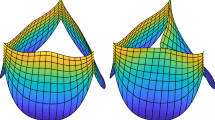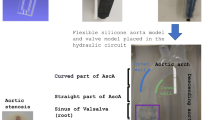Abstract
In this work, we consider the blood fluid-dynamics in the ascending aorta in presence of a normally functioning bicuspid aortic valve (BAV). In particular, we perform an unsteady finite element study in real geometries with physiological velocity boundary conditions at the inlet to assess the effect of the inclusion of the leaflets on the fluid-dynamic abnormalities characterizing BAV cases. To this aim, we perform a comparison in two geometries (a dilated and a non-dilated ones) among three scenarios which are built up for each geometry: BAV without leaflets, BAV with leaflets, and tricuspid case with leaflets. For each case, we compute four indices quantifying flow asymmetry, reversal flows, helical patterns, and wall shear stresses. Our results show that the inclusion of the leaflets increases the fluid-dynamics abnormalities, especially for the non-dilated configuration, which presents a greater increment of the indices. In particular, we observe that the values of the time-averaged wall shear stress and of the systolic jet asymmetry increase by approximatively 100 and 40 %, respectively, when considering the leaflets.











Similar content being viewed by others
References
Atkins S, Cao K, Rajamannan N, Sucosky P (2014) Bicuspid aortic valve hemodynamics induces abnormal medial remodeling in the convexity of porcine ascending aortas. Biomech Model Mechanobiol 13(6):1209–1225
Avolio P (1980) Multi-branched model of the human arterial system. Med Biol Eng Comput 18(6):709–718
Barker A, Markl M (2011) The role of hemodynamics in bicuspid aortic valve disease. Eur J Cardiothorac Surg 39(6):805–806
Barker A, Lanning C, Shandas R (2010) Quantification of hemodynamic wall shear stress in patients with bicuspid aortic valve using phase-contrast mri. Ann Biomed Eng 38(3):788–800
Barker A, Markl M, Burk J, Lorenz R, Bock J, Bauer S, Schulz-Menger J, Von Knobelsdorff-Brenkenhoff F (2012) Bicuspid aortic valve is associated with altered wall shear stress in the ascending aorta. Circ Cardiovasc Imag 5(4):457–466
Bauer M, Siniawski H, Pasic M, Schaumann B, Hetzer R (2006) Different hemodynamic stress of the ascending aorta wall in patients with bicuspid and tricuspid aortic valve. J Card Surg 21(3):218–220
Billiar K, Sacks M (2000) Biaxial mechanical properties of the natural and glutaraldehyde treated aortic valve cusp—part I: Experimental results. J Biomech Eng 122(1):23–30
Borazjani I, Ge L, Sotiropoulos F (2010) High-resolution fluid-structure interaction simulations of flow through a bi-leaflet mechanical heart valve in an anatomic aorta. Ann Biomed Eng 38(2):326–344
Borazjani I, Sotiropoulos F (2010) The effect of implantation orientation of a bileaflet mechanical heart valve on kinematics and hemodynamics in an anatomic aorta. J Biomech Eng 132(11):111005
Borazjani I (2013) Fluid-structure interaction, immersed boundary-finite element method simulations of bio-prosthetic heart valves. Comput Methods Appl Mech Eng 253:103–116
Burman E, Fernandez M, Hansbo P (2006) Continuous interior penalty finite element method for Oseen’s equations. SIAM J Numer Anal 44(3):1248–1274
Caruso MV, Gramigna V, Rossi M, Serraino GF, Renzulli A, Fragomeni G (2015) A computational fluid dynamics comparison between different outflow graft anastomosis locations of Left Ventricular Assist Device (LVAD) in a patient-specific aortic model. Int J Numer Methods Biomed Eng 31(2)
Celik IB, Ghia U, Roache PJ, Freitas CJ, Coleman H, Raad PE (2008) Procedure for estimation and reporting of uncertainty due to discretization in CFD applications. J Fluids Eng Trans ASME 130:1–4
Chandra S, Rajamannan N, Sucosky P (2012) Computational assessment of bicuspid aortic valve wall-shear stress: Implications for calcific aortic valve disease. Biomech Model Mechanobiol 11(7):1085–1096
Conti C, Della Corte A, Votta E, Del Viscovo L, Bancone C, De Santo L, Redaelli A (2010) Biomechanical implications of the congenital bicuspid aortic valve: a finite element study of aortic root function from in vivo data. J Thor Cardiovasc Surg 140(4):890–896
Della Corte A, Bancone C, Conti C, Votta E, Redaelli A, Del Viscovo L, Cotrufo M (2012) Restricted cusp motion in right-left type of bicuspid aortic valves: a new risk marker for aortopathy. J Thorac Cardiovasc Surg 144(2):360–369
Den Reijer P, Sallee D, Van Der Velden P, Zaaijer E, Parks W, Ramamurthy S, Robbie T, Donati G, Lamphier C, Beekman R, Brummer M (2010) Hemodynamic predictors of aortic dilatation in bicuspid aortic valve by velocity-encoded cardiovascular magnetic resonance. J Cardiovasc Magn Reson 12(1)
Donal E, Novaro G, Deserrano D, Popovic Z, Greenberg N, Richards K, Thomas J, Garcia M (2005a) Planimetric assessment of anatomic valve area overestimates effective orifice area in bicuspid aortic stenosis. J Am Soc Echocardiogr 18(12):1392–1398
Donal E, Raud-Raynier P, Coisne D, Allal J, Herpin D (2005b) Tissue doppler echocardiographic quantification. Comparison to coronary angiography results in acute coronary syndrome patients. Cardiovasc Ultrasound 3(10)
Faggiano E, Antiga L, Puppini G, Quarteroni A, Luciani G, Vergara C (2013) Helical flows and asymmetry of blood jet in dilated ascending aorta with normally bicuspid valve. Biomech Model Mechanobiol 12(4):801–813
Fedak P, Verma S, David T, Leask R, Weisel R, Butany J (2002) Clinical and pathophysiological implications of a bicuspid aortic valve. Circulation 106(8):900–904
Formaggia L, Quarteroni A, Veneziani A (2009) Cardiovascular mathematics, modeling and simulation of the circulatory system, vol 1. Springer, Berlin
Girdauskas E, Borger M, Secknus M, Girdauskas G, Kuntze T (2011) Is aortopathy in bicuspid aortic valve disease a congenital defect or a result of abnormal hemodynamics? A critical reappraisal of a one-sided argument. Eur J Cardiothorac Surg 39(6):809–815
Girdauskas E, Disha K, Borger MA, Kuntze T (2012) Relation of bicuspid aortic valve morphology to the dilatation pattern of the proximal aorta: focus on the transvalvular flow. Cardiol Res Pract 1(1)
Guntheroth WG (2008) A critical review of the American college of cardiology/American heart association practice guidelines on bicuspid aortic valve with dilated ascending aorta. Am J Cardiol 102:107–110
Hahn R, Roman M, Mograder A, Devereux R (1992) Association of aortic dilation with regurgitant, stenotic and functionally normal bicuspid aortic valves. J Am Coll Cardiol 19(2):283–288
Hope M, Hope T, Meadows A, Ordovas K, Urbania T, Alley M, Higgins C (2010) Bicuspid aortic valve: four-dimensional mr evaluation of ascending aortic systolic flow patterns. Radiology 255(1):53–61
Hope M, Hope T, Crook S, Ordovas K, Urbania T, Alley M, Higgins C (2011) 4D flow CMR in assessment of valve-related ascending aortic disease. JACC Cardiovasc Imaging 4(7):781–787
Hope M, Sigovan M, Wrenn S, Saloner D, Dyverfeldt P (2014) MRI hemodynamic markers of progressive bicuspid aortic valve-related aortic disease. J Magn Reson Imaging 40(1):140–145
Keshavarz-Motamed Z, Garcia J, Gaillard E, Capoulade R, Le Ven F, Cloutier G, Kadem L, Pibarot P (2014) Non-invasive determination of left ventricular workload in patients with aortic stenosis using magnetic resonance imaging and doppler echocardiography. PLoS One 9(1)
LaDisa J, Taylor C, Feinstein J (2010) Aortic coarctation: recent developments in experimental and computational methods to assess treatments for this simple condition. Prog Pediatr Cardiol 30(1–2):45–49
Lantz J, Renner J, Karlsson M (2011) Wall shear stress in a subject specific human aorta—influence of fluid-structure interaction. Int J Appl Mech 759(3)
Le TB, Sotiropoulos F (2013) Fluid-structure interaction of an aortic heart valve prosthesis driven by an animated anatomic left ventricle. J Comput Phys 244(1):44–62
Luciani G, De Rita F, Lucchese G, Hila D, Rungatscher A, Faggian G, Mazzucco A (2012) Repair of congenitally dysplastic aortic valve by bicuspidization: midterm results. Ann Thorac Surg 94(4):1173–1179
Marom G, Haj-Ali R, Rosenfeld M, SchÃd’fers H, Raanani E (2013a) Aortic root numeric model: annulus diameter prediction of effective height and coaptation in post-aortic valve repair. J Thorac Cardiovasc Surg 145(2):406–411
Marom G, Kim HS, Rosenfeld M, Raanani E, Haj-Ali R (2013b) Fully coupled fluid-structure interaction model of congenital bicuspid aortic valves: effect of asymmetry on hemodynamics. Med Biol Eng Comput 51(8):839–848
May-Newman K, Yin F (1998) A constitutive law for mitral valve tissue. J Biomech Eng 120(1):38–47
Moireau P, Xiao N, Astorino M, Figueroa C, Chapelle D, Taylor C, Gerbeau JF (2012) External tissue support and fluid-structure simulation in blood flows. Biomech Model Mechanobiol 11(1–2):1–18
Nkomo V, Enriquez-Sarano M, Ammash N, Melton L, Bailey K, Desjardins V, Horn R, Tajik A (2003) Bicuspid aortic valve associated with aortic dilatation. Arterioscler Thromb Vasc Biol 23(2):351–356
Pasta S, Phillippi J, Gleason T, Vorp D (2012) Effect of aneurysm on the mechanical dissection properties of the human ascending thoracic aorta. J Thorac Cardiovas Surg 143(2):460–467
Pasta S, Rinaudo A, Luca A, Pilato M, Scardulla C, Gleason T, Vorp D (2013) Difference in hemodynamic and wall stress of ascending thoracic aortic aneurysms with bicuspid and tricuspid aortic valve. J Biomech 46(10):1729–1738
Saikrishnan N, Yap C, Milligan N, Vasilyev N, Yoganathan A (2012) In vitro characterization of bicuspid aortic valve hemodynamics using particle image velocimetry. Ann Biomed Eng 40:1760–1775
Saikrishnan N, Mirabella L, Yoganathan A (2014) Bicuspid aortic valves are associated with increased wall and turbulence shear stress levels compared to trileaflet aortic valves. Biomech Model Mechanobiol. doi:10.1007/s10237-014-0623-3
Schapira J, Martin R, Fowles R (1979) Two dimensional echocardiographic assessment of patients with bioprosthetic valves. Am J Cardiol 43(3):510–519
Sigovan M, Hope M, Dyverfeldt P, Saloner D (2011) Comparison of four-dimensional flow parameters for quantification of flow eccentricity in the ascending aorta. J Magn Reson Imaging 34(5):1226–1230
Tan FPP, Borghi A, Mohiaddin RH, Wood NB, Thom S, Xu XY (2009) Analysis of flow patterns in a patient-specific thoracic aortic aneurysm model. Comput Struct 87(11):680–690
Tse K, Chiu P, Lee H, Ho P (2011) Investigation of hemodynamics in the development of dissecting aneurysm within patient-specific dissecting aneurismal aortas using computational fluid dynamics (CFD) simulations. J Biomech 44(5):827–836
Vergara C, Viscardi F, Antiga L, Luciani G (2012) Influence of bicuspid valve geometry on ascending aortic fluid dynamics: a parametric study. Artif Organs 36(4):368–378
Viscardi F, Vergara C, Antiga L, Merelli S, Veneziani A, Puppini G, Faggian G, Mazzucco A, Luciani G (2010) Comparative finite element model analysis of ascending aortic flow in bicuspid and tricuspid aortic valve. Artif Organs 34(12):1114–1120
Weinberg E, Kaazempur Mofrad M (2008) A multiscale computational comparison of the bicuspid and tricuspid aortic valves in relation to calcific aortic stenosis. J Biomech 41(16):342–348
Wendell DC, Samyn MM, Cava JR, Ellwein LM, Krolikowski MM, Gandy KL, Pelech AN, Shadden SC, LaDisa JF (2013) Including aortic valve morphology in computational fluid dynamics simulations: initial findings and application to aortic coarctation. Med Eng Phys 35(6):723–735
Acknowledgments
This work has been partially supported the Italian MIUR PRIN12 project n. 201289A4LX. The numerical simulations have been performed at CINECA Consortium through the LISA Projects LI02p-FSIA2 and Lisa Project LI02p- LEScarot.
Author information
Authors and Affiliations
Corresponding author
Appendix
Appendix
We provide here some technical details on the 2D CINE PC-MRI acquisition made for Patient 2 at the PC-slice. A 1.5 Tesla system (Magnetom Symphony, Siemens Medical Systems, Erlangen, Germany) has been used. The temporal resolution was characterized by 20 phases in one cardiac cycle with a pixel resolution of \(1.17 \times 1.17\) mm. Velocity encoding values were chosen to optimize the velocity map resolution with a value equal to \(150\) cm/s. The following parameters were also used: TE (echo time) = 6.4 ms; flip angle = \( 15^{\circ }\); slice thickness = 5 mm; acquisition matrix = \(256 \times 256\).
Rights and permissions
About this article
Cite this article
Bonomi, D., Vergara, C., Faggiano, E. et al. Influence of the aortic valve leaflets on the fluid-dynamics in aorta in presence of a normally functioning bicuspid valve. Biomech Model Mechanobiol 14, 1349–1361 (2015). https://doi.org/10.1007/s10237-015-0679-8
Received:
Accepted:
Published:
Issue Date:
DOI: https://doi.org/10.1007/s10237-015-0679-8




